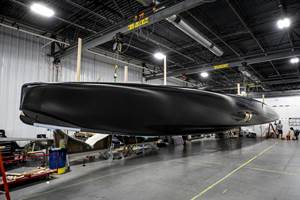Plastic honeycomb goes large-scale
With RENOLIT GORCELL's broad commercialization, recent licensing by Toray, and “cooperation” with Lanxess, EconCore’s continuous thermoplastic honeycomb process gains more followers in pursuit of low-cost panels for mass markets.
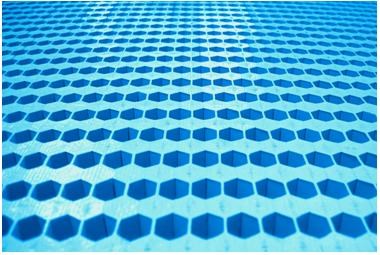
EconCore claims it provides the technology for the most economic
honeycomb sandwich panels and parts. SOURCE: EconCore
(Leuven, Belgium) continuous thermoplastic honeycomb production process called ThermHex has been around for more than a decade. Developed and patented by Belgium’s largest university, KU Leuven (Leuven, Belgium), ThermHex technology enables cost-efficient products using a wide range of polymers including polypropylene (PP), polyester (PET), polyvinyl chloride (PVC), polyamide (PA), acrylonitrile butadiene styrene (ABS), nylon, polyphenylene sulfide (PPS) and many others. The honeycombs can be made directly from an extruder or roll of material with a variety of cell sizes, densities and thicknesses. The resulting honeycombs have closed skin strips, creating more surface area for excellent bonding of skins onto the core. In fact, the process easily allows inline lamination of faceskins and panel post-processing, furthering potential cost reduction.
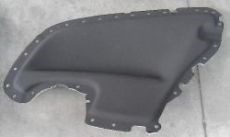
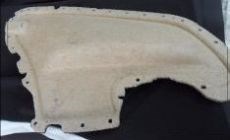
|
​Automotive door panel made of ThermHex honeycomb
with natural fiber / PP composite skins. SOURCE: EconCore
CW reported in April that Toray (Tokyo, Japan) and Itochu (Tokyo, Japan) have licensed the ThermHex technology from EconCore. Toray says it will combine ThermHex with its own core and sandwich panel materials technology called NANOALLOY to offer what is described as extraordinary impact absorption. (See April news item.)
EconCore and (Cologne, Germany) have also announced a “cooperation” agreement to manufacture new honeycomb cores from various polymers including Durethan polyamides using the ThermHex continuous process and to combine these with Tepex continuous fiber-reinforced thermoplastic composites from LANXESS subsidiary Bond-Laminates for use in high-performance composites applications. Hartwig Meier, head of product and applications development in the LANXESS High Performance Materials business unit, detailed, “We expect the thermoplastic sandwich structures, with their high-quality mechanical properties, to be suitable for replacing metal in many areas and thus reducing weight, for instance in motor vehicles, but also in the building and transportation industries, boat and furniture building and motorhome manufacturing.”
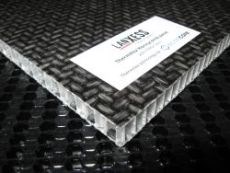
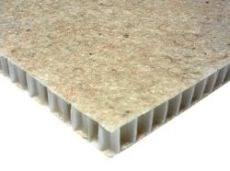
|
Lanxess PA core with TEPEX skins (left) and PP core with
natural fiber skins (right). SOURCE: EconCore.
Another licensee, Renolit GOR (Buriasco, Italy), exhibited its honeycomb products at JEC 2014 (March 11-13, Paris, France) sold into building, furniture and automotive end-uses. According to Axel Kulke, sales director for Renolit Composites, the company has been selling wood plastic composite (WPC) sheets for more than 42 years. “Recently the automotive and building markets have requested development of a material/panel which has still the same characteristics as current WPC but with increased stability and stiffness without adding much weight.” Kulke says Renolit decided to invest in EconCore’s honeycomb technology because it enabled automated production of honeycomb “and then thermo-laminating our WPC sheets on both sides as skins for markets like automotive, furniture, flight cases, van superstructures and floors, marine, facades, booth equipment etc.” Kulke says the RENOLIT GORCELL process is very economical and gentle on energy and other resources. The product won the first prize WPC Innovation Award at the 5th German WPC-Conference (Dec. 10-11, 2013 Cologne, Germany).
Tomasz Czarnecki, technology manager at EconCore, says that Röplast (EskiĹźehir, Turkey) has also licensed the technology, is installing equipment now and will produce panel products under the “Hexapan” brand. “We are looking into creating similar license cases in the U.S.,” he says, “so the momentum is indeed increasing.”
EconCore supports licensees in their development of applications and integration of the ThermHex technology into their production. It continues to explore new material combinations such as thermoplastic cores with aluminum or steel faceskins targeted for interior and exterior cladding, visual communication boards and transportation applications, and PP honeycomb with natural fiber composite skins for automotive interiors. Additional licensees include: Coroplast (Chicago, Ill., USA), Gifu Plastics (Gifu, Japan), Karton (Pordenone, Italy) and ThermHex Waben (Halle, Germany). EconCore has also signed a license agreement with a world leading steel maker to enable continuous production of super strong honeycomb panels with steel facings. The name of the licensee will be announced soon.
Related Content
Pittsburgh engineers receive $259K DARPA award for mussel-inspired underwater adhesion
The proposed META GLUE takes inspiration from hydrogels, liquid crystal elastomers and mussels’ natural bioadhesives to develop highly architected synthetic systems.
Read MoreBelzona composite wrap restores corroded carbon steel pipeline
Two-part epoxy paste, epoxy structural adhesive, composite wrap and anti-corrosion coating prevent environmental and economic loss for customer.
Read MorePro-Set named official materials supplier for New York Yacht Club American Magic
Competitive sailing team prepares for the 37th America’s Cup beginning in August 2024 with adhesives, resins and laminate testing services for its AC75 monohull construction.
Read MoreComposite, adhesive and core solutions focus on performance, reducing carbon footprint
JEC World 2025: Gurit celebrates 190 years with a display of its product variety — from Spabond 400, resins, prepregs and Gurit PET to BalsaFlex, Opticore and other core systems.
Read MoreRead Next
Ultrasonic welding for in-space manufacturing of CFRTP
Agile Ultrasonics and NASA trial robotic-compatible carbon fiber-reinforced thermoplastic ultrasonic welding technology for space structures.
Read MoreCutting 100 pounds, certification time for the X-59 nose cone
Swift Engineering used HyperX software to remove 100 pounds from 38-foot graphite/epoxy cored nose cone for X-59 supersonic aircraft.
Read MoreScaling up, optimizing the flax fiber composite camper
Greenlander’s Sherpa RV cab, which is largely constructed from flax fiber/bio-epoxy sandwich panels, nears commercial production readiness and next-generation scale-up.
Read More







